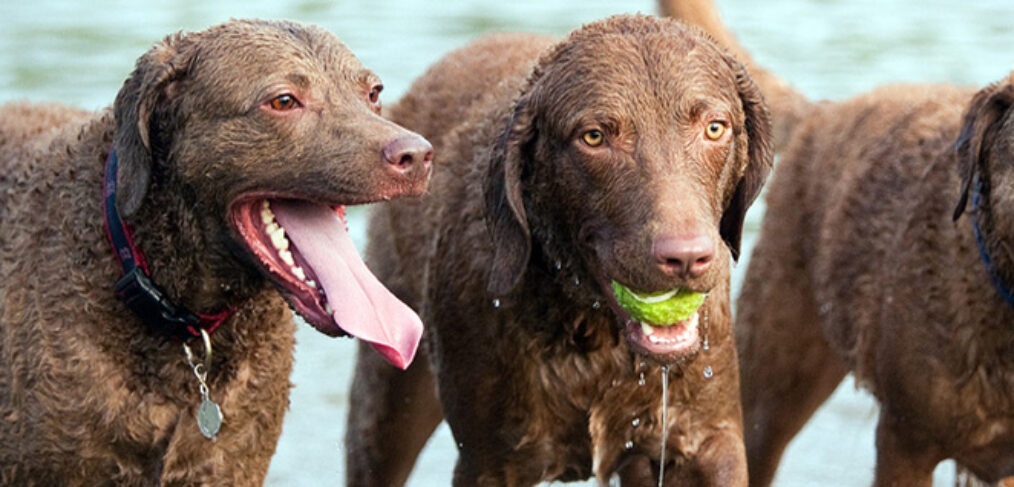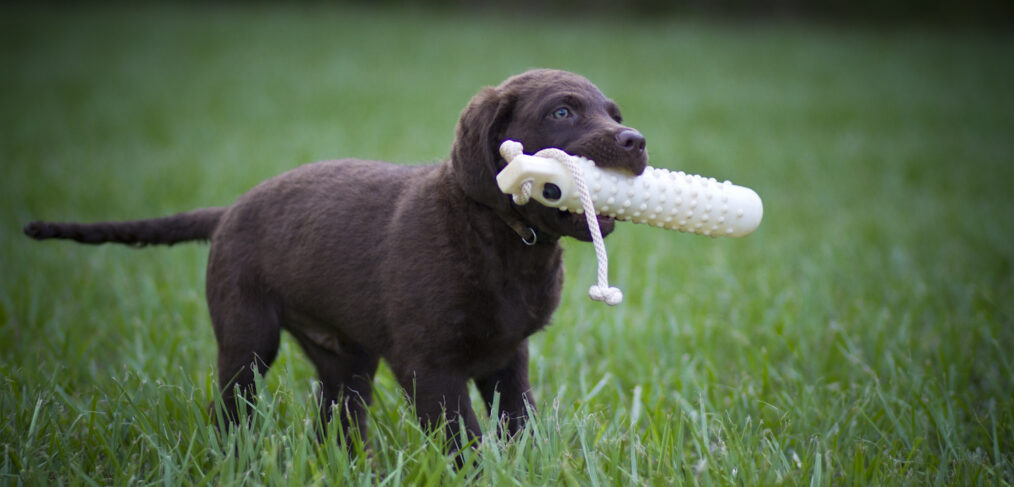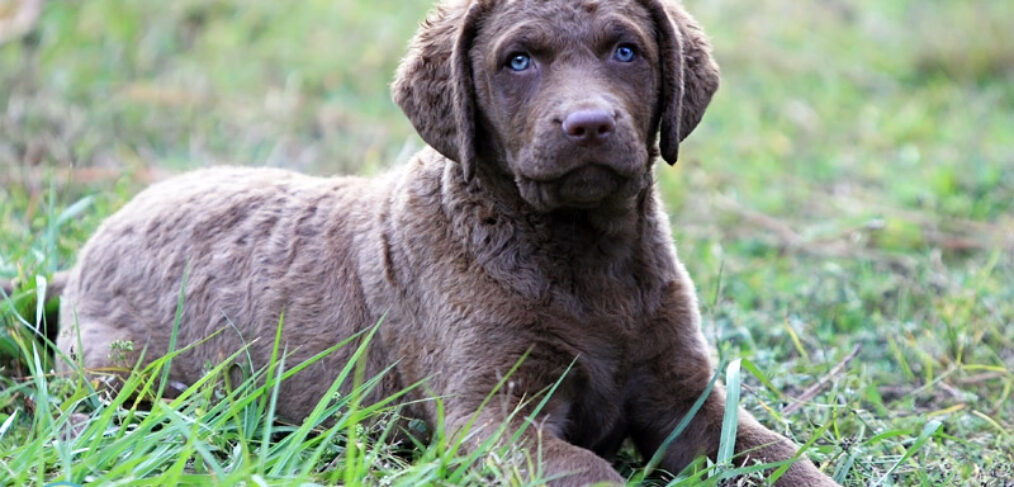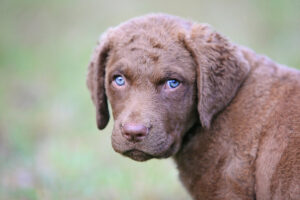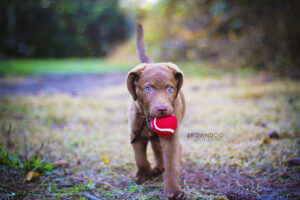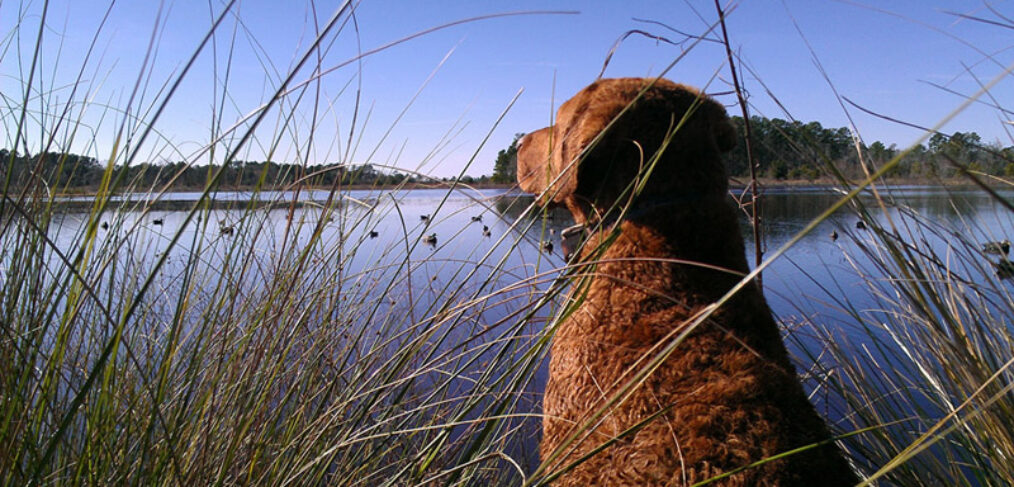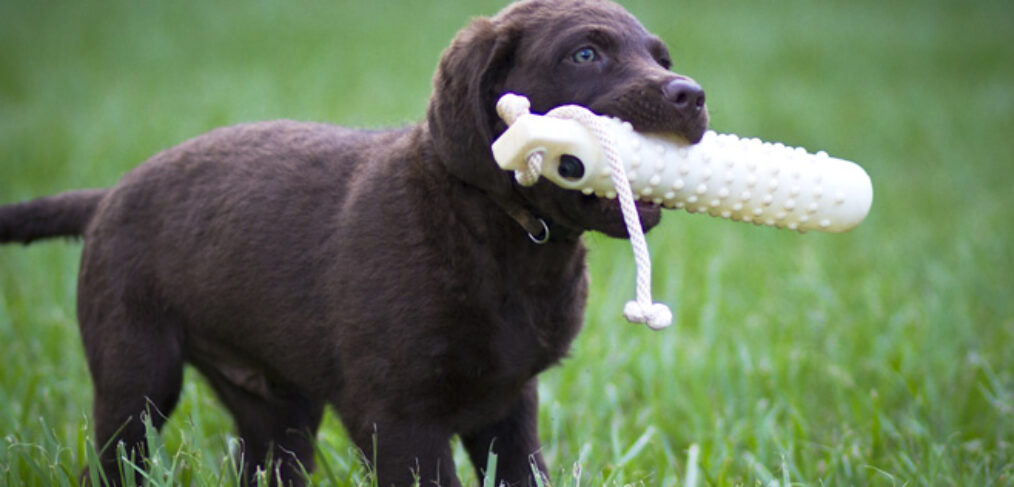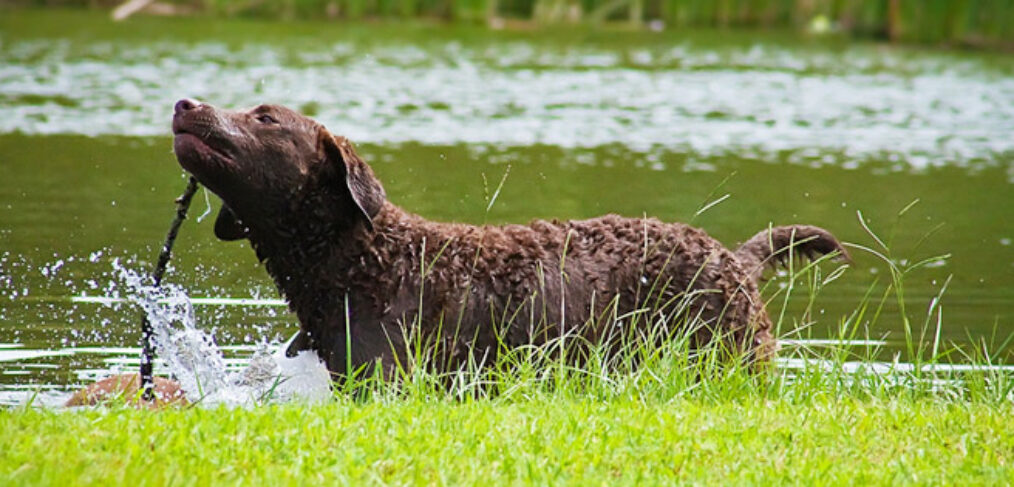What is PRA?
Below are extracted pieces of the article, Breeders Ask Optigen… The Whys and Wherefores of Testing Your Dog for PRA by Mary M. Woodsen. For the purpose of this Web site, it has been condensed and updated for Chesapeake Bay Retrievers.
Chesapeake Bay Retrievers gained access to the first genetic test in 1998. The test is by OptiGen and it detects prcd-PRA (Progressive Retinal Atrophy) in CBRs. The test is now in its third rendition.
What is PRA? Is there any way to treat it? Can I prevent it?
Progressive Retinal Atrophy (PRA–and specifically, the prcd form of PRA) is an inherited eye disease that affects not only Chesapeake Bay Retrievers but several other breeds as well. Dogs with prcd-PRA, over time, go blind.
In most breeds PRA is evident by the time a dog is at least six years old, after it has already been bred. In order to develop PRA, a dog must inherit two copies of the defective prcd-PRA gene: one from its dam, one from its sire. There’s no cure, no treatment; no way to stop it.PRA, however, can be prevented in the next generation even though you can’t treat it in the current generation. Through safe, selective breeding based on a simple DNA test.
Marker-based genetic testing.
There are two general types of marker tests used in genetic testing, and sometimes they’re confused. Our’s is a marker (linkage) test with No Chance of Recombination. This means that the marker is close enough to the gene that its chance of splitting away from that gene during meiosis (sexual reproduction) and skewing the test is less than one in several billion! (Some types of marker [linkage] tests do allow for recombination, which means that the test can give either false positive or false negative results. In other words, a small percentage of dogs that test as genetic normals could actually be a carrier or affected, and visa versa.)
This test, in fact, designates a dog as genetically normal (clear) with absolute, unequivocal, totally reliable, 100%-no-ifs-ands-or-buts accuracy. And that’s good news, because you can take your otherwise really great dog that happens to test as (probable) carrier or (probable) affected and breed it to a certified (no ifs ands or buts) normal–and know that no pup will ever be affected.
What does “probable” carrier and “probable” affected mean?
The problem with markers is this: way back when the first pup was born with a mutated gene, the gene’s marker didn’t mutate too. Indeed, that pup was the very first carrier. Of course, it still had its parents’ other healthy gene, and passed one or the other of the pair along to each of its pups. Today, dogs testing as carriers and affecteds either carry that ancestral pup’s damaged gene-plus-marker–or they carry that pup’s parent’s normal gene-plus-marker. But which gene, which marker? We can’t tell–we haven’t found the gene yet, and the markers look just alike. We call this look-alike marker a false allele.
This ancestral, normal gene-plus-marker–the false allele–is the wild card. Thus a dog may test as Pattern B (probable carrier) yet carry two normal genes, one of which has those look-alike markers. Likewise a probable affected–a Pattern C dog–may carry one damaged and one normal gene–or less likely, two normal genes. That’s why we use the designations “Pattern B” and “Pattern C”: because some Bs aren’t carriers and some Cs aren’t affected.
The marker for Pattern A has never accompanied a mutated gene and thus could never have a false allele.
Explain, please, what an allele is.
Alleles (say it a-lee-el) are different versions of the same gene. Does your sister have brown eyes, your brother hazel eyes, but yours are blue? In humans, eye color is caused by different alleles of the “eye-color gene.” (Eye color is a bit more complex in dogs.) In the same way, genes for retinal functioning have different forms, or alleles, and the defective gene is one. In fact, even markers have alleles. One of those alleles always accompanies the mutated gene, but in its ancestral form, it sometimes accompanies the normal gene.
How can you offer a test if it isn’t accurate?
Our definition of “accuracy” has to do with the detection of the markers used in the laboratory. The OptiGen test for the markers of PRA is exactly accurate. This means that the test gives clear readings in the laboratory; there is no issue of interpreting what we see–no false positive. (A false allele result is not a false positive result.) Numerous controls–absolute measures of accuracy–are used for every sample we process. The results for every dog will never change with age and will be the same whenever this current test is repeated. (In contrast, a false positive reading can change.) Pattern A dogs will always test as Pattern A. Likewise, Bs will always be Bs and Cs will always be Cs. These are lifetime guarantees–and they are accurate. As scientists we are necessarily bound to this definition of accuracy, and could not state it differently.
So a C dog can be normal, clear?
Yes, that’s possible, if it has two false alleles–two look-alike markers. Then sure, it’s actually normal, but this genetic test can’t prove it normal. It may indeed be normal but the best you dare guess, if you have a normal ERG and the dog is over six years old, is that it’s a carrier. You still need to breed it with caution to certified clears. Don’t worry – within a couple generations you can breed completely clear progeny.
Given that a dog comes back as a B or a C, what is the next best course to follow to determine its true genetic status? Should we test its parents, or perhaps its offspring or grandchildren? How do we find out if the dog really has a false allele and what do we do about it?
The markers to the prcd gene are inherited, just as is the prcd gene itself. If the look-alike false allele is involved in one dog, it will be passed from one generation to the next. Which means that testing parents, offspring or grandpups won’t help you figure out that a false allele is involved. If a dog is Pattern C (probable affected) and is bred to an A (no ifs ands or buts, it’s clear) dog, every one of its progeny will (alas) test as Pattern B (probable carrier). Genetics just doesn’t happen any other way. (Depending on what other dogs have been used as mates in the past, offspring of past matings could test as Pattern C, probable affected).
But until we have an improved prcd test, there’s no unequivocal way to determine the true genetic status for the mutation in Pattern B and C dogs–and thus no way to say that any dog definitely has a false allele. “Normal” eye exams and ERGs, the lack of apparent symptoms into old age, even a seemingly flawless pedigree–none of these unequivocally deny the possibility of having at least one mutated gene.
Why bother to run a test that does not detect the false allele?
If you want to prevent PRA this test will do the job. If you want to eliminate the mutated prcd gene from your lines over a span of two or three generations, this test will do the job–if you follow safe breeding practices, using Bs and Cs wisely so as to retain their other excellent qualities. You should test before breeding and always choose a Pattern A dog as one of the breeding pair. If you want to know beyond any conceivable doubt that your dogs are carriers or affecteds, this test will not do the job.
Understandably, it’s difficult for owners to accept that the frequency of the false allele is unknown. It’s human nature to prefer certainty. But give your Bs and Cs two or three generations; you can breed certainty into your line by breeding them only to A dogs–and likely you’ll be ahead of those who decide to wait for the mutation-based test.
Our breeders are flabbergasted about the amount of B’s and C’s. This just cannot be true–and the results certainly aren’t “occasional!” If these dogs are really B or C, we would have had many more blind dogs or dogs with PRA diagnosis, and we don’t. Why?
Indeed, this situation is being reported more often than “occasionally.” This most likely means that the false allele is more common than we initially predicted based on results from the pedigrees in our research group. If we could rewrite our literature, knowing what we know now, we’d suggest a more frequent occurrence of the false allele–even though we still can’t put a number on that frequency.
Part of this situation is due to prcd-PRA being a recessive disease and part is due to the false allele. Consider:
Part I, Recessive inheritance of prcd-PRA:
– If–for example only–the real, true frequency of PRA in Chessies were something like 5%. In such a case, the expected frequency of carriers in the population-at-large would be 35%. That is just a fact of inheritance based on calculations of gene frequencies of recessive conditions. Even that number might seem high to breeders. To our knowledge, the real frequency of PRA in Chessies isn’t known. We have used 5% only as an example to show that even with a low frequency of prcd-PRA, the carrier frequency would be considerably higher.
Part II, that ignominious false allele:
– The false allele is still hidden among the Pattern Bs and Pattern Cs. We don’t know what percentage of dogs have false alleles, but it surely inflates the actual numbers of Bs and Cs.
Keep in mind, though–the real reason we offered the test in its current form is to identify Pattern As, or genetic normals: those dogs that definitely
– have no prcd gene;
– cannot pass on a prcd gene;
– will never become affected.
This provides the foundation for safe breeding of all dogs. Would we be doing breeders a favor by withholding this test?
Likewise, the test is valuable in reliably identifying Pattern B dogs that will never become affected with PRA.
Why not breed B x B, since B just means that the dog involved is not an affected dog?
It is true that Pattern B means the dog is not affected. But Pattern B dogs have a high risk of being carriers, and B plus B could equal C. Even if you have the best-kept pedigree in town, do you want to take the risk of breeding Cs? Cs can turn out to be affected.
Breedings of B x B yield an average of 1/4 As, 1/2 Bs, 1/4 Cs. So, this breeding can produce Bs at high risk of being carriers and Cs at high risk of being affected.
We were in the process of getting our dog’s championship with the idea of future breeding. She’s a C. Do you recommend terminating this course of action?
We can’t make specific recommendations about how people should handle their dogs. But health-wise and breeding-wise, there’s no absolutely reason to change your plan. Why? Three reasons:
– if your Pattern C dog is between 18 months and 6 years of age and has current and reliable ERG and CERF results, there’s a fair chance she has a false allele and might never get PRA;
– if she does get PRA, she may not be affected significantly before getting her championship, and she will bear that honor for life;
– even if she is affected, she will never produce a PRA-affected pup if bred only to Pattern A dogs–but she could produce a champion.
Analyzing the pedigree of your B or C dog will add information. If your dog has absolutely no prcd-PRA documented in an extensive pedigree that you can trust, chances decrease that it has two true mutant genes. (Keep in mind that in the old days–not that many years ago–owners sometimes didn’t recognize or understand PRA, or may have been afraid to reveal that a dog had it.)
If this test has a large margin of error in diagnosing carriers and affecteds, won’t it limit our gene pool to the point that other problems will become more of an issue?
Whether and how we limit the gene pool is a really important issue. After all, some conditions–hip dysplasia is an example–are so genetically complex that practically every dog has the capacity for some degree of disability, be it so mild it’s almost undetectable or so severe it’s totally disabling. Fortunately, PRA isn’t like that. Clear dogs aren’t mostly clear–they’re clear. The gene isn’t partly recessive–it’s recessive. Carriers and affecteds bred to clears produce disease-free pups.
Indeed, the best thing about the test for prcd-PRA is that it helps keep the gene pool from shrinking. You need to pull a dog with bad hips because scientists don’t know enough about the disease to prevent passing it on. But you’ll never need to pull any dog because of a B or C OptiGen prcd-PRA reading. Bs or Cs bred to As will never produce affected pups.
Often it’s the breeders who suspect they have a problem that test first. If breeders test actively within the breed, they’ll identify increasingly large percentages of As–which will benefit all breeders. In fact, other breed clubs have had exactly that experience. (Each quarter, OptiGen’s website posts the test result percentages.)
How can I use this test to eliminate the defective gene from my line?
Find out everything you can about your dog–then breed or don’t breed according to the absence or presence of traits and health considerations you have no control over. Don’t let the traits you can control dictate your breeding decisions. You now have control over prcd-PRA. An OptiGen-tested Pattern B or C dog can be bred to a Pattern A dog without producing affected offspring. B pups can be bred again to As. This is how you eliminate the defective gene from your line.
Your C dog’s progeny will all be Bs, so you don’t need to test them. (Unsure about how basic genetics works? Check OptiGen’s web site.)
How far away in time and $$ is OptiGen from the new, direct gene test?
The research to solve the false allele is going full steam ahead. It is the main focus of the labs supervised by Drs. Aguirre and Acland. But with research you can’t really say when the result you seek will be found. That’s what research is all about– searching for something that is yet unrevealed. In our case, we know what needs to be done and exactly how to do it, but we don’t know when we’ll get there. All we can say is that every day we are closer because every day more has been done to achieve our goal. That’s why our research needs continued support.
Will the next test be 100% accurate and, if not, what accuracy percentage will it be?
The goal is to develop the next test so that it continues to give the accurate diagnosis of normal, but also gives an absolute (no ifs ands or buts) diagnosis of carrier and affected status–with no false allele problem. The new test will change the categories we attach to dogs, and they will be categorized as Normal, Carrier, or Affected.
How do you sum up the value of this test?
Many beautiful animals over the years developed prcd-PRA and were removed from breeding programs never to be bred again. Now these animals can be used without the fear of producing more blind dogs. The OptiGen prcd-PRA test allows breeders to present their Bs and Cs with pride for all their other prize qualities.
We ask again–would we be doing anyone a favor by withholding this information until the mutated gene is found?
For detailed information for the science behind genetic testing, see Mary M. Woodsen’s articles inDog News:
The Genetic Advantage: Baker Institute at Cornell University Releases New Tests for Progressive Retinal Atrophy, May 14, 1999
Marking the Spot: Genetic Testing and the Occasional False-Allele, June 25, 1999

